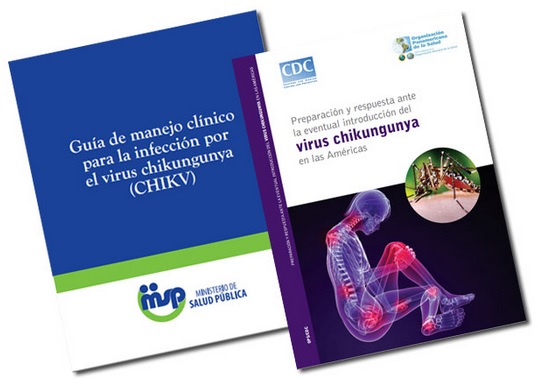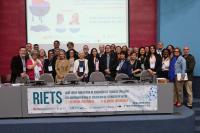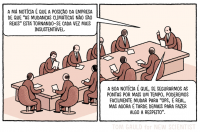Dominican Republic is first country in the Americas to publish guidelines for clinical management of chikungunya
 Prepared by the Ministry of Public Health with support from PAHO/WHO, the guidelines facilitate timely diagnosis and appropriate treatment of the disease. For Dr. Andrea Santana, a family doctor at the Plaza de Salud General Hospital in Santo Domingo, the word chikungunya barely existed in her medical vocabulary until a few months ago.
Prepared by the Ministry of Public Health with support from PAHO/WHO, the guidelines facilitate timely diagnosis and appropriate treatment of the disease. For Dr. Andrea Santana, a family doctor at the Plaza de Salud General Hospital in Santo Domingo, the word chikungunya barely existed in her medical vocabulary until a few months ago.
“Chikungunya is new for us. We are only seeing it now,” she said of the virus, which was first imported into the Dominican Republic from other territories in the Caribbean in early April. Since then, the virus has spread to 19 provinces, sickening more than 193,000 people and claiming three lives (as of early July).
The virus’s name, taken from the Makonde language of south-central Africa, refers to the common effect it has of causing sufferers to “bend over” in pain. The virus is carried by infected Aedes aegypti and Aedes albopictus mosquitoes, the same species that transmit dengue virus.
To contend with the medical community’s lack of knowledge of the disease, the Dominican Republic’s Ministry of Public Health, with support from the Pan American Health Organization/World Health Organization (PAHO/WHO), in May released a guide for the clinical management of patients, distributing it to public and private hospitals throughout the country.
“Now when a patient arrives with high fever, arthralgia [joint pain], and rash, we know that we are seeing symptoms of chikungunya,” said Santana, who received training on the disease based on the new guide. She and other health professionals treat symptomatic patients who arrive at a chikungunya clinic that was created at the Plaza de Salud Hospital in early June especially for this purpose.
Symptoms of chikungunya, which also include headache and muscular pain, usually appear three to seven days after a person is bitten by an infected mosquito. The disease is only rarely fatal, but the joint pain it causes can last for months or even years for some.
What the guide says
The guide gives specific recommendations to help health workers “make timely clinical diagnoses and treat the disease appropriately,” said Minister of Public Health and Social Welfare Freddy Hidalgo in launching the new guide.
With just over 50 pages, the pocket-sized publication discusses the definition, symptoms, clinical phases, diagnosis, treatment, and epidemiology of chikungunya. It also includes important information for patients along with quality of care indicators and a flowchart for the treatment process. The guide was based on an existing 2011 publication, Preparedness and Response for Chikungunya Virus Introduction in the Americas, developed by PAHO/WHO in collaboration with the U.S. Centers for Disease Control and Prevention (CDC).
There is no specific drug or vaccine for the virus; treatment of its acute phase is aimed at reducing fever and relieving joint pain. “Rest, hydration, and acetaminophen are what we recommend,” said Dr. Julquias Hidalgo, who treats patients in the special chikungunya clinic.
“When a patient arrives with adenopathies [swollen lymph nodes], high fever that lasts more than three days, and other symptoms, we do a routine blood analysis to rule out other diseases, primarily dengue,” Hidalgo explains. In about half of patients, a rash appears when the fever and pain diminish, at which point the guide recommends zinc-oxide-based or cooling lotions that contain aloe vera, menthol, or camphor to relieve the typically intense itching.
PAHO/WHO’s representative in the Dominican Republic, Dr. Lilian Reneau-Vernon, said the clinical guide has been very useful in coping with a disease that was unknown in the country. The entire population is at risk of the disease, which has spread rapidly because of people’s lack of previous exposure to it. The presence of the Aedes aegyptimosquito is another factor contributing to the rapid spread, she noted.
Protocol and guidelines
Dr. David Jiménez, coordinator of the Family and Community Medicine Residency program at the Juan Pablo Pina Hospital in San Cristóbal, sees patients in the hospital’s chapel, which was first adapted to treat cholera patients and is now used for patients with symptoms of chikungunya.
“We began to manage the first cases according to a protocol that we downloaded from the PAHO/WHO website and have subsequently used a protocol established jointly by the Ministry of Health and PAHO/WHO,” he said.
Jiménez recalled that during the peak of the outbreak in his area, as many as 130 patients per day were arriving at the hospital. “Out of those affected by the disease, we have given priority to high-risk groups: pregnant women, children under age 1, patients over 65, and individuals with comorbidities,” he said.
Health authorities recommend that most patients with chikungunya remain at home until their symptoms diminish, usually in three to seven days. However, “If patients present warning signs such as fever lasting over three days, persistent and intense abdominal pain, or altered consciousness, they should immediately go to a healthcare facility,” said Dr. José Moya, an epidemiologist in PAHO/WHO’s country office and one of the experts who developed the clinical guide.
In all, more 350,000 suspected cases and 21 deaths from chikungunya have been reported by 23 countries and territories in the Americas since PAHO/WHO’s first epidemiological alert on chikungunya, issued on 9 December 2013 after the first indigenously transmitted cases of the virus in the Americas were reported. An additional 13 countries in the Region have reported imported cases. (Data as of 11 July 2014.)
PAHO/WHO has provided both on-site and virtual training to prepare the Region’s countries and health professionals to respond to the virus, drawing on the experience of the Dominican Republic, among others.



